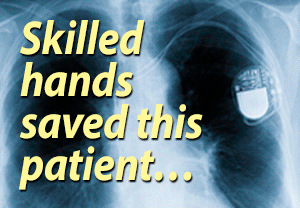 Pacemaker
Pacemaker
- by Survivor
- 2024-01-05 21:02:18
- Batteries & Leads
- 487 views
- 3 comments
Well my 10 year old pacemaker tried to do me in.
little did I know one of the two leads had frayed.....I was having mini blackouts which I thought was strange.
i had a PM checkup which revealed I had over 2000 events....yes 2000..... events.
i wasn't happy with the manufacturer as i should have been notified this could happen.
Thankfully i have a new PM now and everything has settled down.
3 Comments
Leads
by piglet22 - 2024-01-06 05:10:57
I spent years working with instrumentation, a lot of it with signals like pH and redox which are similar to physiological signals like those in heart function and pacemakers.
These signals are best described as fragile.
Leads and connectors are paramount and have to be of the highest quality.
It's bad enough working when the leads are accessible, but put them in a damp, constantly moving environment like the human body and things get really difficult.
I'm assuming that PM leads are specifically designed and will have multiple layers like the conductors, shielding, insulation, protection and anything going wrong can have a profound effect.
One of the hardest bits is the lead to device connection where the lead goes from flexible to fixed.
In my experience, this junction is the weakest point and how many items like power supplies and computer leads get binned because the conductor wires have flexed too much and broken.
One of the downsides of copper conductors is that copper hardens by flexing, work hardening, making it more likely to break.
I don't know what exactly is meant by frayed. Normally reserved for woven fabrics, it can apply to the woven copper mesh called the shield.
If the is the case and the shield is compromised then the signal quality is degraded, the worst thing that can happen with a pacemaker
It's a fact of life that things go wrong despite the best planning and design.
Critical components in the most safety important things like space shuttle launch systems can and did go wrong.
It's remarkable that our devices last for years given what we put them through.
Let this be a lesson to us all. Read the pacemaker report!
by Gotrhythm - 2024-01-07 14:18:45
I'm sorry you've had a hard time. Having mini blackouts must have been scary.
But I'm not sure the fault lies with the manufacturer. The manufacturer knows the leads are a vulnerable part of the pacemaker. And so does every member of your cardiac care team--from the doctor to the pacemaker techs. They are your first line of defense. Every time you go for a pacemaker check, how well the leads are transmitting the signal is the first thing they look at. And the first part of the pacemaker report that they give you is all about how well the leads are functioning.
I'm wondering if your pacemaker checks for the last year or so failed to indicate that a problem was developing? Did the problem with the leads happen suddenly, out of the blue? Have you asked why the problem wasn't caught sooner?
When I look at my pacemaker report, I admit I have been guilty of skipping over the information about the leads because words like ohms and impedence mean nothing to me. The numbers associated with them mean even less. They are there for a reason though, and it behooves us to pay attention.
Your experience teaches a lesson that we need to get a copy of every pacemaker report and read it every part of it for ourselves. If we don't understand it, we need to ask for explanation.
You know you're wired when...
You always have something close to your heart.
Member Quotes
Pacemakers are very reliable devices.

.png)



Good it’s fixed
by Lavender - 2024-01-05 22:34:09
Ten years is good on a pacemaker. Did they extract the frayed lead and replace it? I would think your monitor would have caught this.